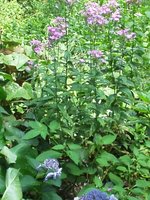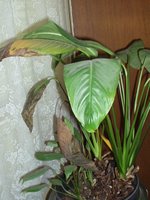My Big, Fat Green Thumb
Over the years I have at times been famous for my plant-care skills. At one time I had over 50 thriving houseplants, including a couple of large ficus trees (a lyre ficus served as a Christmas tree before I went to graduate school). My Victorian apartment had two huge picture windows in the kitchen in which I hung a rather strange set of plant shelves made of string and wood that somehow stayed up by leaning on dowels and using the plants' own weight to hold the dowels in place. Since my apartment was upstairs and had no air conditioning, I kept the windows (behind the shelves) wide open. One afternoon there was an epic summer thunderstorm and the wind blew the entire contraption to the floor. This happened while I was at work, and I did not have the pleasure of seeing the new, all-dirt-and-pot kitchen "carpeting" until I was well and thoroughly tired after my day.
Not to be undone, I simply screamed loudly once, and got to the sweeping. I had to go to K-Mart to get a bunch of new pots and soil. I replanted everything. I did this with cheer and actually kind of felt better afterward, as though purged and renewed.
I've also had some pretty spectacular vegetable gardens in my time. One was on the outskirts of Chapel Hill on two acres behind the duplex where I lived. Enough room for potatoes, melons, long rows of corn and even peanuts. There were other things, too: several kinds of beans, squash, cantaloupe, watermelon, 'maters, zucchini and summer squash, Chinese vegetables, broccoli, peppers, and multiple varieties of lettuce. In Albuquerque, among many other organic things, I had squash coming out my ears and sunflowers seven feet tall with faces the size of dinner plates.
Thus it is a testimony to my decline in older age that I am neither so gung-ho about plants nor so gifted in maintaining their thriving lifestyle. After having children, my attention has frankly been heavily deflected elsewhere and I rarely slow down long enough to remember the pure joy I used to get from nurturing really healthy plants. I really did used to feel ecstatic about them, especially the blue African violets. Also, plants don't talk back or whine or manipulate or hit you.
Don't even ask about my attitude toward outdoors plants these days. The physical situation of living in relentless tangly woods with yards that are 100% shade all times of day has put a damper on any aspirations I have had to grow sunflowers and veggies. I confess to a very strong hankering for homegrown, juicy, sweet tomatoes, squash and pole beans. I have considered razing historic trees to get a little shaft of sunlight spread broadly enough to grow sunflowers and square Japanese watermelons. But growing conditions are rotten here, and I am convinced that between the shade, unmitigatable weeds, relentless poison ivy and ravenous deer, to start a garden here and expect it to live to germination and beyond would be folly. I am also, sometimes, a tad bit negligent. I don't always notice problems until they are well underway.
Let me introduce you to my hall of shame. Such as this:
 Heh, heh. Oops. This is a seashell in which I planted the offspring of a spider plant that originally occupied the shell. The mother plant I transplanted, and she's doing fine. But somehow this baby didn't like being in the shell. I cared for it devotedly, but apparently the soil I had was infested with some sort of white fungus, and killed the plant despite my ministrations. Too sad. Not even my mother, a plant hater and self-described "Black Thumb," could kill a spider plant if she tried. They live through everything. My mother-in-law keeps them overwintered for six months WITHOUT EVEN BEING HOME or watering them, and they do just fine.
Heh, heh. Oops. This is a seashell in which I planted the offspring of a spider plant that originally occupied the shell. The mother plant I transplanted, and she's doing fine. But somehow this baby didn't like being in the shell. I cared for it devotedly, but apparently the soil I had was infested with some sort of white fungus, and killed the plant despite my ministrations. Too sad. Not even my mother, a plant hater and self-described "Black Thumb," could kill a spider plant if she tried. They live through everything. My mother-in-law keeps them overwintered for six months WITHOUT EVEN BEING HOME or watering them, and they do just fine.Then there's the Hinoki, which is typically a charming diminutive relative of junipers and cedars:

You are wondering: "What Hinoki? All I see is a stick." For almost four years I have been trying to save the Hinoki. It started out as a cute little tree--think Bonsai-like-- that grew naturally in a spiral pattern and was about two feet tall. But I knew it was ailing from the beginning. So I pruned it and cut away all the sick parts and washed it and loosened the soil and mulched it. Then, this March, the roofers droped the roof on it and broke eight inches of its top clean off. The rest of it just looked pathetic. It had never responded to my care. So I've decided to dig it out and replace it with something else. But to make it easier to dispose of, I cut off all its branches . . . here's what's currently left, in all its splendid humiliation. Thank goodness no one who knows us actually comes to the front doorstep and sees that.
And another hallmark of shame is the little table in the dining room, which bears what remains of a plant I got eight years ago and initially named the QEP (quite enormous plant). This was was once a magnificent spathyphillum. At one time it took up an entire corner of our little arts and crafts livingroom in Illinois. I bought it at great [that is, highly inflated] price from a well-reputed greenhouse in the Chicago suburb of Evanston. At that time it was huge and thriving, and bore one large spathe flower, which looks kind of like a calla lily. This plant has borne a couple of new little plants, but despite growing vigorous new leaves, has never flowered again IN EIGHT YEARS, and the developed leaves seem to be browning and dying at a faster rate than they are being replaced.
*Weep*. If only you had seen it in its former glory, you'd know how tragic this is.
But not absolutely everything is dead:
 The coleus I put in containers this year out of sheer desperation to find something that could survive in the shade are doing quite well. So are the spikes and the vinca, which always deliver.
The coleus I put in containers this year out of sheer desperation to find something that could survive in the shade are doing quite well. So are the spikes and the vinca, which always deliver. The hydrangea I cut back last year came back like gangbusters, and its shape is much improved. It blocks the entire living room picture window:
The hydrangea I cut back last year came back like gangbusters, and its shape is much improved. It blocks the entire living room picture window:
And the deer might actually have missed the buds on one of the daylilies we brought from New York state (but note the weeds are trying):
 Best of all, the once gorgeous hydrangea on the edge of the stone porch, which has NEVER bloomed in any of the summers we've lived here, finally blooomed because I figured out how to conquer its powdery mildew problem:
Best of all, the once gorgeous hydrangea on the edge of the stone porch, which has NEVER bloomed in any of the summers we've lived here, finally blooomed because I figured out how to conquer its powdery mildew problem: Online it looks like a Nikko Blue, but it is really a lacecap and it is a deep, bright orchid color, much more purple than it looks here. Because I solved the powedery mildew problem, the phlox were happy and bloomed this year, too.
Online it looks like a Nikko Blue, but it is really a lacecap and it is a deep, bright orchid color, much more purple than it looks here. Because I solved the powedery mildew problem, the phlox were happy and bloomed this year, too. Of course, since they are on the steepest part of a nearly inaccessible hill, they are flanked by weeds just as towering as they are. But it's very exciting to get something to come back after years of failure. I used to hate phlox. We had them in Chicago and I thought they were a common weed. I spent two whole weekends hacking out what seemed to be a LOG of a root system, and the darned thing lived anyway. Then I moved to the land of Noah Webster, whose colonial home is right here a few blocks away. The Webster dooryard is full of towering phlox. When we toured the house we learned that the Websters had been weavers, and phlox was the plant from which we get flax--the raw fibers for linen. Ever since then I have held the phlox in high esteem and am happy to let it occupy one of the only tiny patches of sun we get. It reminds me of Noah and his swell dictionary.
Of course, since they are on the steepest part of a nearly inaccessible hill, they are flanked by weeds just as towering as they are. But it's very exciting to get something to come back after years of failure. I used to hate phlox. We had them in Chicago and I thought they were a common weed. I spent two whole weekends hacking out what seemed to be a LOG of a root system, and the darned thing lived anyway. Then I moved to the land of Noah Webster, whose colonial home is right here a few blocks away. The Webster dooryard is full of towering phlox. When we toured the house we learned that the Websters had been weavers, and phlox was the plant from which we get flax--the raw fibers for linen. Ever since then I have held the phlox in high esteem and am happy to let it occupy one of the only tiny patches of sun we get. It reminds me of Noah and his swell dictionary.





0 Comments:
Post a Comment
<< Home